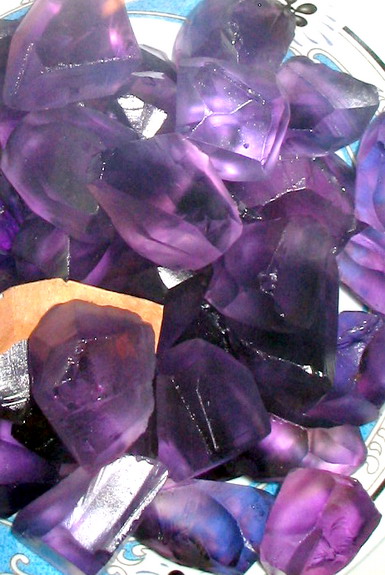
Are Gemstones Minerals
As colorful as the rainbow and as sparkling as fine leaded crystal, gemstones have captured the imaginations and desires of men and perhaps especially, women, for ages. The pursuit of gems have become the subject of legends, fairy tales, epics, and major motion pictures ("Romancing the Stone", for one). Today, more fine gemstone specimens are available to the average person than at any time in history.

What makes a gemstone?
Generally speaking, a gemstone is a stone that is beautiful, rare, and durable (resistant to abrasion, fracturing and chemical reactions). Some minerals can be very beautiful, but they may be too soft and will scratch easily (such as the mineral fluorite). Fluorite is extremely colorful and pretty but has a hardness of only 4 on the Moh's hardness scale and has four perfect cleavage directions, which makes it only an oddity as a cut gem. Others are too common and are given a semi-precious status (such as agate). Most gemstones have good hardness (above 5) and a high index of refraction (the higher the index of refraction the greater the sparkle). All gemstones have some characteristics falling short of perfection though; even the seemingly perfect Diamond has four directions of cleavage. Note that the most common mineral in the Earth's crust is quartz, with a hardness of 7. Since quartz is everywhere (especially in common dirt and dust), any material that is softer may be scratched during ordinary wear.

Most gems are silicates which can be very stable, hard minerals. A few gems are oxides and only one gem, diamond, is composed of a single element, carbon. There are also many gemstones that are not true minerals, but which are gemstone varieties of recognized minerals. In most cases, these variety names are historical, as the gemstones were not recognized as being varieties of other minerals until well after the name was in common use (such as aquamarine, emerald, and heliodor as varieties of beryl). Often, new names will be created for ordinary sounding minerals which sound prettier or more valuable, such as "Moldavite" for the green variety of tektites. In some cases, the names are true misnomers, such as "Green Amethyst" for prasiolite (a transparent green variety of quartz).

A few gemstones are mineraloids (not true minerals) and are included below: opal, amber, and moldavite. Pearls don't even qualify as mineraloids, as they are not only the result of an organic process plus they are properly composites, containing both the mineral aragonite and the protein conchiolin.
While almost any mineral can be cut in the manner of a gemstone, below is a list of some of the gem kingdom's more prized and recognized members:

What makes a Precious Metal
Like gemstones, one of the characteristics of a precious metal is its rarity. It could not be "precious" if it were common! Two other characteristics are also important. Foremost is durability - it must not easily corrode away, nor can it be brittle. And that is related to the third characteristic, ductility. This means that the metal must be malleable, that it can be bent, hammered, or otherwise shaped. Gold is the most malleable of metals (it can be hammered into incredibly thin foils or drawn into extremely fine wires), it does not corrode or dissolve except under the most extreme conditions. It is so durable that nearly all of the gold ever mined is still in circulation or storage.

Are Gemstones Minerals

No comments:
Post a Comment
Hi, please feel free to share your comment here.
For example: Which pictures is the best?
Thanks,
Admin